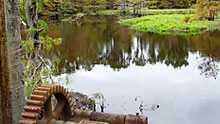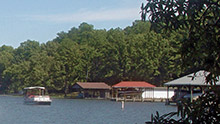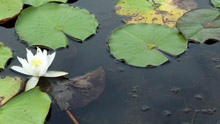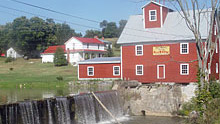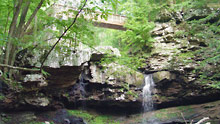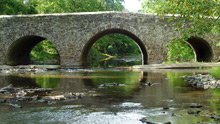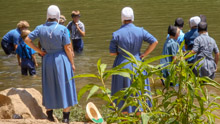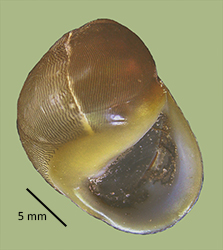Neritina reclivata (Say 1822)
> Habitat & Distribution
Thompson (1999) gave the range of N. usnea as "both coasts of Florida, and widely distributed in brackish water in the Caribbean and Gulf of Mexico region." He added "invades freshwater zone in lower parts of some rivers." We have records from the lower portions of the Apalachicola, Ochlockonee, St. Marks, and Suwannee Rivers. Always found grazing on solid surfaces rocks, macrophytes, and large woody debris. We often spot them grazing across the exposed surfaces of emergent vegetation, see below. FWGNA incidence unranked.
> Ecology & Life History
The Neritimorpha is an ancient order of gastropods, primarily marine but with many (possibly independent) invasions of fresh water. Some tropical neritids demonstrate dramatic catadromous life cycles - freshwater adults laying eggs which hatch into planktonic larvae, swept downstream into the sea for development, adults ultimately returning on foot. Our single North American representative in fresh waters, Neritina usnea, however, completes its life cycle from egg to simple crawl-away juvenile to adult in what we biologists of The FWGNA Project characterize as the normal, freshwater gastropod fashion.
Sexes are separate in the neritids, males distinguished by a penis that arises from the head behind the right tentacle and lies curled under the mantle when not in use. No detailed ecological studies have been directed toward N. usnea, but the European freshwater neritid Theodoxus fluviatilis is a nonspecific grazer (Dillon 2000: 85-86).
Theodoxus populations demonstrate great diversity of life history. Becker (1949) reported two generations per year in a German population, while McMahon (1980) reported that a single generation required three years in Ireland.
> Taxonomy & Systematics
Described as Nerita usnea by the German Peter Friedrich Roding in 1798 with little more than a common name and a figure, the taxon was transferred first to Neritina by Lamarck (1816) and then to Morch's (1852) Vitta by Eichhorst (2016). Neritina reclivata (Say, 1822) is a junior synonym.
> Maps and Supplementary Resources
- Neritina distribution in Georgia and the Florida panhandle (2025).
- Neritina usnea grazing across a bed of macrophytes in the Wakulla River.
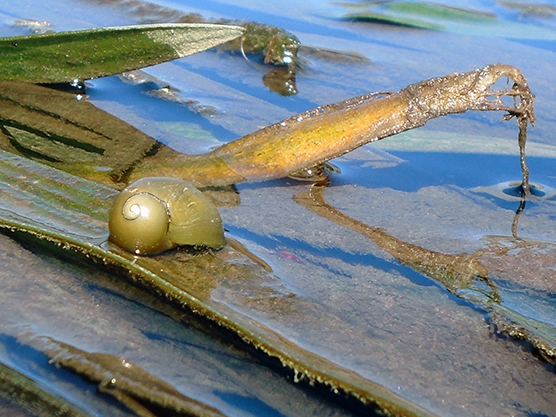
> Essays
- I reviewed the lovely selection of freshwater nerites available for aquarium hobbyists in my blog post of 21Dec17, Pet Shop Malacology. The most popular species for the home aquarium here are entirely mysterious in their provenance but probably all wild-harvested from the Old-World tropics, somewhere.
> References
Becker, K. (1949) Untersuchungen uber das Farbmuster und das Wachsturm der Molluskenschale. Biologisches Zentralblatt 68: 263 288.
Dillon, R. T., Jr. (2000) The Ecology of Freshwater Molluscs. Cambridge, Cambridge University Press. 509 pp.
Eichhorst, T. E. (2016). Neritidae of the world. Volume two. Harxheim, Conchbooks. Pp. 695-1366.
Lamarck, [J. B. P. A. de M. de]. (1816). Tableau encyclop dique et m thodique des trois r gnes de la nature, Mollusques et polypes divers. Part 23 [Livraison 84, 14 December 1816], Tome 3, pp. 1-16, pls. 391-431, 431 bis, 431 bis*, 432-488, Paris: Vve Agasse.
McMahon, R. (1980) Life-cycles of four species of freshwater snails from Ireland. American Zoologist 20: 927.
R ding, P. F. (1798). Museum Boltenianum sive Catalogus cimeliorum e tribus regnis natur qu olim collegerat Joa. Fried Bolten, M. D. p. d. per XL. annos proto physicus Hamburgensis. Pars secunda continens Conchylia sive Testacea univalvia, bivalvia & multivalvia. Trapp, Hamburg, viii + 199 pp
Say, T. (1822). An account of some of the marine shells of the United States. Journal of the Academy of Natural Sciences, Philadelphia. 2(1): 221-248; 2(2): 257-276, 302-325.
Thompson, F.G. (1999) An identification manual for the freshwater snails of Florida. Walkerana 10: 1 96.

